=================================================================
To subscribe, unsubscribe or change your email address, visit:
http://www.imaging-resource.com/IRNEWS/index-subs.html
Support the Newsletter!
- Find the best price for anything at http://ir.pricegrabber.com
- Shop Amazon, Adorama at http://www.imaging-resource.com/buynow.htm
========================================================
THE IMAGING RESOURCE DIGITAL PHOTOGRAPHY NEWSLETTER
========================================================
Volume 16, Number 11 - 30 May 2014
----------------------------------------------------------------------------
Copyright 2014, The Imaging Resource. All rights reserved.
----------------------------------------------------------------------------
Welcome to the 388th edition of The Imaging Resource Newsletter!
Welcome to your regularly scheduled Imaging Resource Newsletter for May 30th! To start things off, there's another enhancement coming to Imaging Resource, and this time it's the design of our camera reviews! We've already done a slight tweak to our site's design, revealed an in-depth camera comparison tool, and now we've made our comprehensive, in-depth camera reviews much easier to navigate.
For camera reviews, Eamon Hickey's put the Sony A6000's much-touted AF performance through an extensive test (read: 2,500 frames worth) in his second Shooter's Report installment. In a new lens review, we've given the big, bright, pro-level Samsung 85mm f/1.4 NX lens a tour of lab; is this expensive lens the best portrait lens for NX-mount?
In the Quick Hits section, samples, samples and more samples! We've sample gallery images from Panasonic's super-hot flagship ILC, the 4K-shooting GH4. We also have a slew of lab shots from the pocketable, selfie-friendly Samsung NX Mini, as well as a set of 4 popular superzoom cameras.
Finally, we share some of the most popular news stories from this past week, including a big mirrorless camera AF shootout versus the Nikon D4S and a nice set of quick tips for getting the best portraits of young children. Other news stories include a new update to DxO Optics Pro pairs it up with Adobe Lightroom, Ricoh announces availability for the new 645Z and NASA puts together a 3.2-gigapixel image of Earth... made of selfies.
Happy reading!
---
EDITOR'S NOTE: New newsletter email address - nleditor@imaging-resource.com
We apologize to all of our reader's who've emailed us for our long-running reader emails and questions section of the newsletter and never received a response. Our old newsletter editor email address got completely overwhelmed with irrelevant PR emails and spam, to the point that it just wasn't workable to sort through the hundreds and hundreds of messages to find the reader queries. The new address -- nleditor@imaging-resource.com -- is pristine, though, so we'll be able to easily see and respond to all of you, just like old times. Have a question or comment? Just ask!
(Further apologies from Dave on this - We've been just crazy-swamped with work this last couple of weeks, so there are a number of questions queued that I haven't managed to get to. So apologies to all who've been waiting, I'll try to get to them by next issue!)
---
TOPICS
------------
- Get Social with IR
- Sponsors
- Reviews:
- Sony A6000 Shooter's Report, Part II
- Samsung 85mm f/1.4 Lens Review
- Feature:
- Introducing our new review format!
- Quick Hits:
- Panasonic GH4 Sample Gallery Images
- Samsung NX Mini First Shots
- "Super Tuesday" - First Shots from 4 popular super zooms
- Popular News
- Next Issue
- Signoff
GET SOCIAL WITH IR
----------------------------------
If you want to stay up-to-date with the latest camera and photography news, get notified when IR posts its latest camera or lens review, and much more, get social with us on your favorite networking sites by:
By doing so, you'll also be supporting our efforts to deliver the best camera and photography content on the planet. (Google in particular appears to pay lots of attention to Google+ in deciding site/page relevance for its search results, so "circling" us there and +1-ing our site and pages would be an especially big help.) Thanks! We appreciate it!
SPONSORS
-----------------
This issue is sponsored in part by the following companies. Please show your appreciation by visiting the links below. (Visiting our sponsor's links really helps support this newsletter, thank you for your attention!) And now a word from our sponsors:
* Sigma *
---------
Sigma's approach to photographic equipment is based on quality, craftsmanship, value, customization and
responsibility to photographers and the environment. All encompassed in our breakthrough, award winning
Global Vision lenses:
18-35mm F1.8 DC HSM
35mm F1.4 DG HSM
17-70mm F2.8-4 DC Macro OS HSM
120-300mm F2.8 DG OS HSM
USB Dock
All designed to deliver the highest optical quality and performance.
* Imaging Resource*
------------------------
Did you know that anything you buy from Amazon can support IR, if you just use one of our
links to access the site? Here's a link with our affiliate code in it; click on it, and we'll get a credit
for anything you purchase in the next 24 hours!
http://www.amazon.com/?tag=theimagingres-20
No added cost to you, but a nice boost for us, to help us keep producing this content!
Thanks!
-----------------------------------------------------------------------------------------------------
Are you in the digital photo business? This newsletter is read by more than 47,000 direct subscribers (plus additional pass-along readers), all with a passion for digital photography. For information on how you can reach them, contact us at nleditor@imaging-resource.com
-----------------------------------------------------------------------------------------------------
Camera Review: Sony A6000 Shooter's Report Part II
Focusing on a world in motion
by Eamon Hickey
In this shooter's report installment I'll backtrack a little and talk about the Sony A6000's feel and handling, and then move on to a deeper discussion and real world testing of the highly touted AF performance.
Handling. When I first unpacked the Sony Alpha 6000, it felt immediately familiar. To me, its shape, size, and weight seem similar to the NEX-6 and NEX-7. That's also true of the way it feels in my hand, and that's a good thing. I find all three models very easy to hold securely, even with just a couple of fingers. I've now carried the A6000 for more than 15 hours on 12 different outings, and I have no complaints at all about its portability and comfort. As we noted above, it feels reasonably solid, but I felt a little cautious about torquing it too much when the large Sony FE 70-200mm F4 G OSS lens was mounted. [Note: Image comparisons beside the NEX-6 can be seen in our A6000 overview.]
In my first hour with the Sony Alpha 6000, I spent a fair bit of time checking out the buttons, dials, and menus. The control placement works very well for me. I can quite easily reach the AEL button (which I use for autofocus) and both control dials with my thumb, and the custom and function buttons are also readily accessible, meaning I can make fast settings changes. We mentioned the new menu system in our overview, and I'll just add that it's as big an improvement in use as you would hope. I'd give a lot to get my NEX-7 updated to the new menu layout.
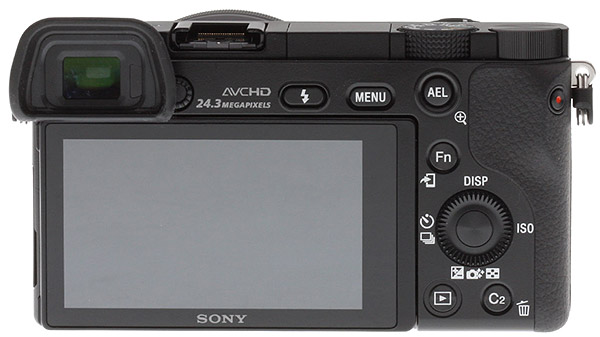 |
Autofocus. In part 1 of this report, I noted that the Sony A6000's single-shot AF (AF-S) is lightning fast, as Sony claims. I found it quite quick and decisive even in moderately low light when I shot some pictures of a friend in a restaurant. In extremely dim light, the AF did slow down, taking half a second or a second to focus sometimes, and it failed to acquire focus on some low contrast subjects in that light. But in every other circumstance where I've used AF-S, it's been terrific.
The headline news on the Sony A6000, however, is its claimed improvements in continuous AF (AF-C) on moving subjects. To test those claims, I've shot almost 2,500 photos in more than 150 burst sequences of flying birds, dogs at play, soccer, flag football, sprinters, joggers, and bicyclists in light ranging from bright daylight to dark overcast. I happen to also be reviewing the�Nikon D4S, which I shot side-by-side with the A6000 as a kind of benchmark to measure it against. On the spec sheet, they both claim to be able to do continuous follow focus at 11 frames per second. [Please read the important caveats and qualifications that I note at the end of this section.]
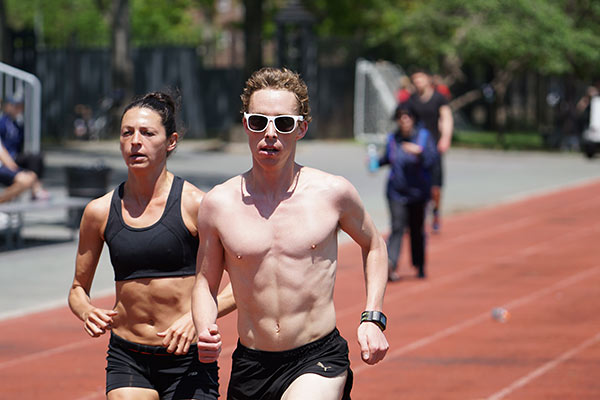 |
| FE 70-200mm F4 G OSS, 202mm eq., f/4, 1/1000s, ISO 100 |
Framing speed.�Judging by their scorching pace, this pair are current or former collegiate runners. East River Park, NYC. |
After some initial warm up shoots (the birds and the dogs were mostly a bust, but I learned a lot about the camera's AF system), I took the Sony A6000 out one afternoon to a soccer field in my neighborhood. It was fairly dark overcast -- about EV 8 or 9 (ISO 100). I shot everything with the FE 70-200mm lens, using f/4.0 in order to give the shallowest possible depth-of-field and thus better reveal focusing errors. The burst speed was set to Continuous Hi (11 fps) and Optical Steady-Shot was on (mode 1).
As I shot, I suspected that both the Wide and Zone AF area modes covered too much of the frame for soccer; they were being fooled into focusing on players who were behind or beside the player with the ball. I had Focus Lock-On activated, which is supposed to track a subject's position within the frame, passing it from focus point to focus point as it moves across the frame. It works pretty well when there is an individual object against a distant background, but it didn't seem to help much in the chaotic action of soccer. The Center AF area mode was fooled less often, but I had more trouble keeping it on target.
When I picked up the Nikon D4S to shoot with it for awhile, I noticed something else that seemed very odd. I was seemingly better at predicting the action with the D4S -- I was catching more peak moments. My strong sense is that the electronic viewfinder of the A6000, with its slight delay, was causing me to react late when the ball was passed and the action shifted. The optical viewfinder of the D4S has no equivalent delay, but on the other hand, the camera does blackout the viewfinder briefly for every frame. Whatever the precise cause, there was no question that I was slightly, but noticeably, faster at following changing action with the D4S. It's of no real concern to me overall, but if shooting sports for money was in my game plan (it's not), this would drop the A6000 off my shopping list.
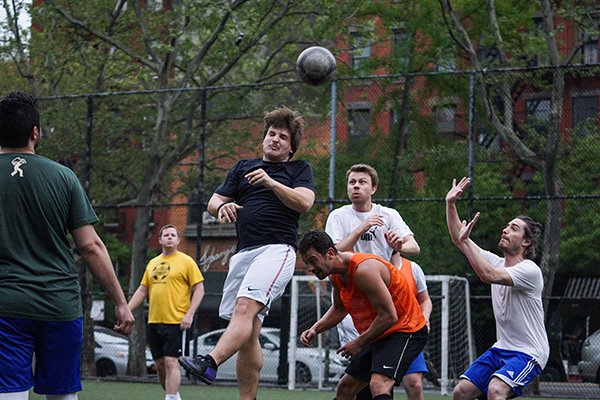 |
| FE 70-200mm F4 G OSS, 105mm eq., f/4, 1/1000s, ISO 3200 |
Using their heads�in a pickup soccer game at Nike Field, Lower East Side, NYC. First shot is in focus, although I was already prefocused near this general spot on the field. Light level is dark & overcast -- (EV 8 or 9 at ISO 100).
|
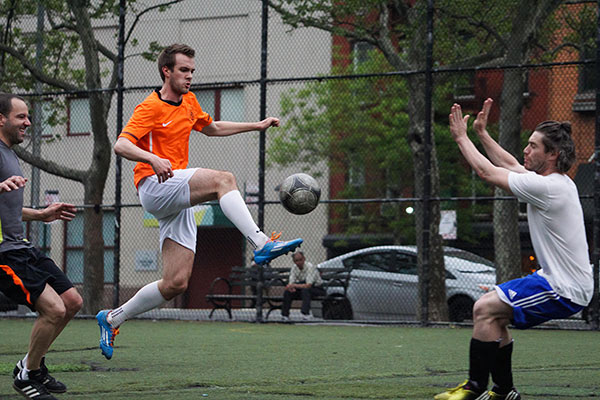 |
| FE 70-200mm F4 G OSS, 160mm eq., f/4, 1/1000s, ISO 3200 |
Flying for soccer glory�in pickup game at Nike Field, Lower East Side, NYC. Light level is deep overcast -- (EV 8 or 9 at ISO 100). These two edited versions have been brightened, originals can be viewed in our�image gallery. |
When I examined my pictures closely later, I saw that, yes, the Wide and Zone AF area modes were often fooled into focusing on the wrong subject. My first shot or three in any given sequence were also often not really sharp, although the camera would usually catch up in later frames. To tally up my approximate hit rate -- i.e. sharp shots vs. soft shots -- I didn't count aborted sequences or ones where I knew or strongly suspected that I had messed up. With those caveats stated, my hit rate in typical properly executed burst sequences was roughly 50%.
It's important to understand that number in context. A 50% hit rate at 11 frames-per-second works out to 5 or 6 sharp pictures per second. That's pretty good, and comparable or better than what most DSLR cameras in the A6000's price range can do.
Let me also note another important thing at this point: judging sharpness is partly subjective. I'm fairly sure I have a stricter standard for sharpness than many photographers. It's also important to remember that whether a photo is usably sharp depends a great deal on how large you plan to display it. A picture that is not pin sharp -- and would get a failing grade from me for this report -- will probably look fine in a smaller print or on Facebook. See the collage image of the runner that we've posted�here�for a sense of how I graded sharpness.
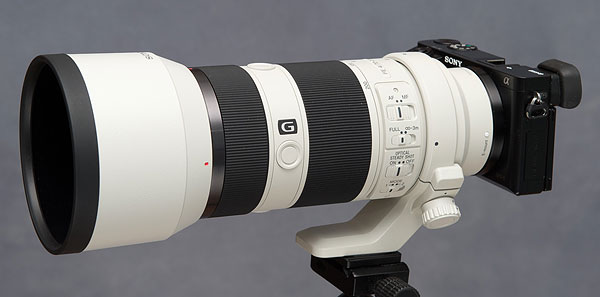 |
Who's zoomin' who?�The full-frame Sony FE 70-200mm f/4 lens dwarfs the A6000. |
A few days after my soccer outing, I took a walk to East River Park and found a high school girls flag football game in full swing. The light was good -- sunny late afternoon, or about EV 14 (ISO 100). As before, I shot everything with the FE 70-200mm lens, wide open at f/4.0. Here again, the Sony Alpha 6000's available AF area modes were not ideal: both Wide and Zone area modes could be fooled by objects (i.e. players) I didn't want to focus on, and Center area was a little difficult to keep on target. When I looked at my images later, I tallied up 130 frames and a hit rate of around 40-50% in typical burst sequences. (I'm giving a rough number for hit rates in this report because even in a decently executed burst some mis-focused images were probably my fault, not the camera's, and because the sharpness of many shots is arguable.)
Multi-player sports like soccer and football are where the smartest AF area modes that you see on higher-end (and some mid-level) DSLRs, and the sophisticated software algorithms that underlie them, are a big help. For both the soccer and the football, I used the smaller Dynamic AF area modes (d9 and d21) on the Nikon D4S, and it was much better at grabbing the player I wanted it to grab and then sticking with them. Because the action is so unpredictable, these sports also put a premium on initial focus acquisition -- i.e. when you swing the camera quickly to re-aim on a new point of peak action you want that first or second shot to be sharp. With the A6000, the first 2 to 3 frames of these sequences were frequently somewhat soft.
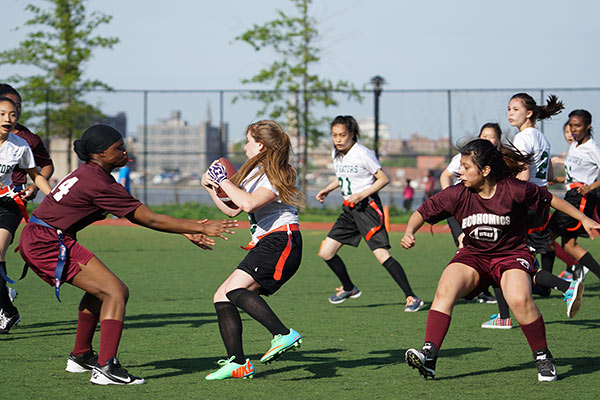 |
| FE 70-200mm F4 G OSS, 184mm eq., f/4, 1/1000s, ISO 100 |
The ol' dipsy-doodle between defenders�in high school flag football at East River Park, NYC. Part of a burst sequence where the hit rate was about 50%. |
After the football, I found some sprinters, joggers, and bicyclists to shoot in other areas of East River Park. Here the Zone AF area mode on the Sony A6000 worked well (no other players to distract it). The position, pace, and direction of the subjects were also more predictable. In total, I photographed almost 20 burst sequences of these subjects, with several comprising 35-40 frames. On these subjects, my hit rate in typical sequences was a bit higher on average -- ranging from 50-65% or so, burst to burst.
Here again, the first few frames in a burst sequence were often soft, even when I had carefully pre-focused for a second or two on the approaching runner or cyclist. I also noticed that the sharp and soft images seem to come in clusters. The camera will get 2 or 3 sharp in a row, then 2 or 3 soft, then back to sharp again. The collage image of the runner gives a sense of this. In a fairly small minority of my burst sequences, I saw 7 or 8 consecutive soft frames before the camera recovered. In a perfect world, I'd rather see a more random distribution of sharp and soft, or quicker recovery to sharp, so as not to have peak moments pass by with, say, 5 consecutive soft images.
|
| FE 70-200mm F4 G OSS, 202mm eq., f/4, 1/2500s, ISO 500, 100% crop |
Shown above is one frame from an 11-frame collage at 100% for judging sharpness. Clicking on the image will bring you to a carrier page where you can access the full collage at 100%. This example is roughly typical of the average 50-50 hit rate I experienced with the A6000's AF-C mode. |
A quick side note: While shooting the bicyclists on the promenade at East River Park, I twice had a chance to put the custom settings memory function to work, both times when I looked up to notice ships passing on the river. As I jumped up from my bench and made the three-second dash to the promenade railing, it was very quick to switch from my "sports" AF-C, JPEG-only custom setup to my "standard" AF-S, RAW+JPEG setup and get the shot. I praised this feature in part 1 of this report, and this is the reason why.
 |
| FE 70-200mm F4 G OSS, 154mm eq., f/5.6, 1/1600s, ISO 200 |
Ship motoring by�the 130-year-old Domino Sugar refinery, East River, NYC.
|
 |
| FE 70-200mm F4 G OSS, 300mm eq., f/4, 1/1000s, ISO 100 |
(Crazy?) man standing�at the point where three barges are lashed together as a tugboat pushes them up the East River, NYC. |
On two later days, I went back to East River Park and shot another 70 sequences of soccer, sprinting, and bicycling to test some additional variables. Somewhat to my surprise, switching the drive mode to Continuous Mid, which shoots at about 6 frames per second, did not seem to affect my hit rate noticeably -- it remained about 40-60%, depending on the sport, yielding 2-4 sharp images per second. It also made soccer action, which requires frequent rapid re-aiming of the camera, harder to track (though it did not have that affect on sprinters and bicyclists).
So, in my tests, the faster Continuous Hi mode had a clear advantage, giving about twice as many sharp images in any given time period. Switching OSS off seemed to drop my hit rate modestly. I also tested Center AF area mode on sports that don't have multiple players (sprinters and bicyclists), but my hit rate was about the same as with the Zone AF area mode. I should also note that in my collection of more than 150 bursts, there are some outliers with no obvious explanation: two or three where the hit rate was 75% or better, and, conversely, maybe 8 or 10 where the hit rate was below 25%.
|
| FE 70-200mm F4 G OSS, 205mm eq., f/4, 1/1000s, ISO 250 |
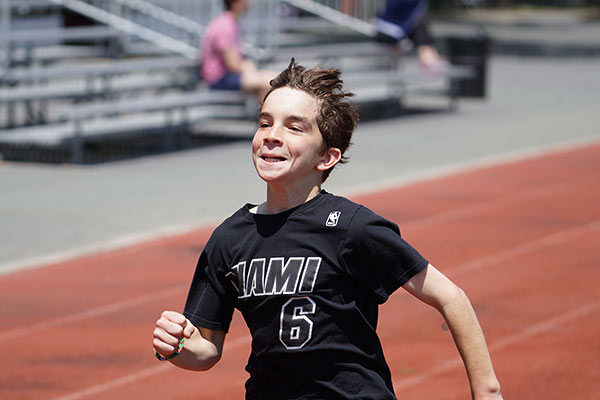 |
| FE 70-200mm F4 G OSS, 202mm eq., f/4, 1/1000s, ISO 100 |
Solo moving subjects�were easier targets for the A6000's continuous AF in general than team competitions. |
So what's the executive summary? My experience with the Sony Alpha 6000 is that it did a pretty decent job with multi-player fast action sports, but it would benefit from more sophisticated AF area modes and better initial focus acquisition. Still, I got many bursts of 8 to 12 images with 3 to 6 sharp shots. Not bad at all. For these sports, I would use Center AF area mode.
For action with fewer obstacles and steadier motion like running and bicycling, Zone AF area works fairly well, and the camera's hit rate went up a bit -- to about 50-60% in typical sequences -- although the first few frames of any given burst were still often soft, even with pre-focusing. But again, overall, this is very respectable for a camera at this price.
I won't belabor this, but I know many of you are curious, so I'll say that my success rate with the Nikon D4S was much, much higher. Its Dynamic AF area modes are much better for multi-player sports; it nails the first image nearly always; and on steady-state motion like bicycles, it almost never misses. But remember that the D4S would easily best a $650 Nikon DSLR, too. That the Sony A6000 can deliver 4-6 sharp images per second on a reasonably regular basis is very impressive for a mirrorless ILC camera costing 1/10th the price of the D4S.
Now some caveats you should keep in mind: Remember that I am one photographer. I have 25 years shooting experience, including action and sports with pro-level AF cameras and lenses, but I am not a pro sports photographer. The pros are a lot better than I am, trust me. I was working with one lens; other Sony lenses are undoubtedly different than the FE 70-200 (some will definitely be slower, others might be faster). I didn't test every sport or action subject and all have their unique characteristics. Even basketball and soccer differ from each other. Crucially, I didn't get to test indoor sports, where gym lighting can put extra stress on an AF system. [Editor's note: Our reviewer Dave Pardue shot the A6000 with this lens at an indoor hockey game and reports similar results with burst mode success -- citing that the first few frames were generally soft, and he got a success rate of ~35-45% of frames being sharp on average. A few of the sharper images are on display in our<
a href="http://www.imaging-resource.com/PRODS/sony-a6000/sony-a6000GALLERY.HTM" target="_blank">A6000 gallery.]
|
| FE 70-200mm F4 G OSS, 208mm eq., f/4, 1/1000s, ISO 160 |
For installment 3 of this user report, I'll let go of my AF obsession (2500 frames? What was I thinking?), and look at the rest of the A6000's resume. In the meantime, be sure to add your comments and questions over on the A6000 review.
---
Lens Review: Samsung 85mm f/1.4
A great pro-level portrait prime for NX photographers
by William Brawley
Are you a Samsung NX camera owner in need of a fast, well-built, professional-level portrait prime? We've just published our review on the�Samsung 85mm �/1.4 ED SSA lens, which is part of Samsung's premium, professional line of lenses and is the "cr�me de la cr�me" of portrait lenses for NX users. Regardless of its physical properties, -- which feel more like a heavy DSLR lens than your typical mirrorless system lens -- the Samsung 85mm �/1.4 lens boasts some impressive specs, including Super Sonic Actuator (SSA) for fast, silent focusing; Extra Low Dispersion glass; and a 9-bladed rounded aperture diaphragm, that along with the wide �/1.4 aperture, makes for creamy, smooth bokeh.�
So, how does this professional portrait prime stack up? The Samsung 85mm �/1.4 produces super sharp images, though not tack sharp at �/1.4 unfortunately -- things are bit soft -- however, stopping down just a little bit and sharpness ramps way up. The other optical qualities of this lens are top-notch: low CA, low vignetting and practically zero distortion. The addition of Samsung's i-Function ring for added camera controls is a very cool feature, especially on certain NX cameras that lack a lot of physical dials and controls. The AF is a bit on the slow side (though it is quiet), however for short changes in subject distance, it's still relatively quick. All in all,�the Samsung 85mm �/1.4 ED SSA is fantastic portrait lens for Samsung shooters.
Jump on over to SLRgear to read our full�Samsung 85mm �/1.4 ED SSA lens review�to see our test results and read our final verdict, which are based on RAW file output.
The Samsung 85mm �/1.4 ED SSA ships with front and rear caps, lens hood and a pouch for around $849 --�Amazon;�Adorama;�B&H. By purchasing this lens, or any other product from one of our trusted affiliates helps support this site and keeps these reviews coming!
In the meantime, check out some sample photos shot by our senior lens technician Rob Murray using the Samsung NX300. You can view more sample photos, plus download the full-resolution files, over at�our Flickr page.
|
| NX300: 85mm, f/1.4, 1/3200s, ISO 100 |
|
| NX300: 85mm, f/1.4, 1/125s, ISO 400 |
|
| NX300: 85mm, f/4.5, 1/100s, ISO 3200 |
-----------------------------------------------------------------------------------------------------
FEATURE: Introducing our new review format - making the content you want easier to find
by IR Staff
This year you've watched us update the overall look of our site, bringing onboard a new logo and generally sprucing the place up a bit. Now, we're rolling out a whole new review layout to go along with our new look.
Once upon a time, we decided to pull content from the various tabs and subtabs of our reviews back onto the main landing page, so readers wouldn't have to click as much to get to what they wanted. That worked well at the time, and many readers liked the change. As time has gone on and our reviews have continued to evolve, though, we've arrived at the point where it's time to go back in the other direction.
We're proud that we're putting up what we believe are some of the best camera reviews on the Internet, but our main home pages for cameras have been getting longer and longer and loooonger in the process. Even reading and referring to the material ourselves, we've been conscious of how much scrolling it takes to access it all.
The new layout is designed to give you (and us!) a more cohesive and user-friendly experience. We're moving important review sections to their own pages, and giving you a quick-glance preview of them on the camera's homepage, beneath each camera's general overview section. This will let you very quickly browse through what we've posted, and pick what you're most interested in reading. Each little "preview pod" gives you taste of what the section is about, and you can click the link at the bottom, or anywhere within the preview pod itself to go read it.
|
| This is an example of one of our new preview pods from a recent Shooter's Report |
These new preview pods include our shooter's reports, technical write-ups, image quality comparisons, etc. The compact nature should make it much easier for you to browse for content and find what you're looking for much faster. And if you already know where you'd like to go, you can also access all of the content via the tabs at the top of every page of the review (including the ever-popular "conclusion" tab for those of you who just can't wait), or in the dropdown jump menu on the right side of the review page.
Thus far, we've offered this new format in the Sony A6000, Panasonic GH4, Pentax K-3,�Olympus E-M10�and�Panasonic GM1 reviews, and will have a few more reworked early next week. We'
ll gradually work through the most popular older reviews on our site, and will be adopting the new format for all new reviews going forward. Feel free to have a browse through and see what you think!
As with all new endeavors we're currently working through a few minor bugs, but even with it still a little rough around the edges, we're very excited, and hope that you'll like our new approach. As always, we're more than interested in what you (our bosses) have to say. So please visit the comments section at the bottom of this page and let us know your thoughts on this new layout concept.
And, as always, thanks for being a part of our community!
-The IR Editorial Team
-----------------------------------------------------------------------------------------------------
QUICK HITS
---
Panasonic GH4 gallery images: the flagship ILC and 4K-shooting monster hits the streets of New Orleans
by William Brawley
Out of the lab and onto the streets! The streets of News Orleans, that is. The Panasonic GH4 review process continues with our first big set of�real-world sample photos, as well as some sample 4K videos, one of which is embedded below, with the rest on our�YouTube channel. (If you want to see the videos in all their crisp, 4K goodness -- without YouTube's re-compression -- and are lucky enough to own a 4K display, there are links in the video comments to download the unprocessed video files).
I was recently down in The Big Easy shooting with the mighty little�Olympus TG-3, and I figured I'd bring along the GH4 for good measure, as the vibrant city would make for some excellent images for our�Panasonic GH4 review. Shot with the sharp�Panasonic 12-35mm f/2.8 lens, both still images and 4K video from the GH4 look crisp and vibrant. I've even pulled some frame-grabs from a few of the 4K videos, for all your pixel-peeping pleasure.
|
| Watch on YouTube. Download the full resolution video�here�(492.5MB). |
For anyone new to our site, this�gallery page�provides thumbnail images and by clicking on one you'll be taken to a carrier page where you can access more information, like full EXIF data, as well as the full resolution image. All images are straight-out-of-camera JPEGS (raw files are provided on most gallery pages as well for some of the images) and you are welcome to download any of the images to use for your own (non-commercial) testing purposes.
Happy pixel-peeping, and stay tuned for more to come on the�Panasonic GH4!
|
GH4 + Panasonic 12-35mm f/2.8: 12mm, f/2.8, 1/1000s, ISO 200 |
|
| GH4 + Panasonic 12-35mm f/2.8: 35mm, f/5.6, 1/3200s, ISO 200 |
|
| GH4 + Panasonic 12-35mm f/2.8: 12mm, f/2.8, 1/6400s, ISO 200 |
[quick-links:�Panasonic GH4���GH4 Gallery���GH4 First Shots]
---
Samsung NX Mini - Initial gallery images posted
by�Dave Pardue
I was excited to hold the Samsung NX Mini for the first time, as it just has this "engineering marvel" feel about it. It's quite compact, yes, but it also feels solid and potent. Naturally, I couldn't wait to sneak it out of the lab for some real world shooting fun.
The trouble is, they only sent us the 9mm (24mm eq.) prime that comes with one of the kit options, and have as yet been unable to get us the kit zoom lens (a 3x 9-27mm), nor the lens mount adapter that allows for shooting with standard NX mount lenses. I thought for a day about waiting, and then couldn't resist a weekend outing even though I imagined I'd be fairly limited in scope by the wide angle prime.
I'm happy to report that I had a ball with the�NX Mini�and this little 9mm prime lens, and didn't miss the additional options a bit. Maybe it was a great way to experience the camera for the first time in it's truly small form factor, before adding any heft to it for the sake of different focal lengths or settings. I took my kids on a Sunday excursion to a state park and fired away, and as you can expect, it felt a lot more like a compact camera or smartphone than most any ILC I've ever hiked with. Certainly the�Panasonic GM1�and the�Olympus E-PM2�are great hiking ILCs with very small form factors for what they are, but the NX Mini does take it a step further in the slim and trim direction, especially with the 9mm attached - both camera and lens barely top 1.25 inches in total thickness. (Of course, it is only fair to the other mentioned cameras to note that they have sensors that are roughly twice the size of the sensor found in the NX Mini.)
The initial 21 images I've posted are waiting for you to scope, pixel peep and analyze in our Samsung NX Mini Gallery. Below are a few selections for a quick glance, all straight from the camera JPEGs with no post-processing other than a re-size to fit this page. All images were shot handheld except for the one mentioned tripod shot.
|
| 1/500s / f/4 / ISO 400 ("cool" filter engaged) |
|
| 1/8s / f/3.5 / ISO 800 (shot on a tripod with the "retro" filter engaged) |
As always, from our�gallery page�you can access the full resolution files as delivered by the camera, RAW files where applicable and the full EXIF data. Stay tuned for our full report of the Samsung NX Mini coming soon.
[quick links:�Samsung NX Mini���Gallery���First Shots]
-----------------------------------------------------------------------------------------------------
POPULAR ON THE SITE
--------------------------------------------
At http://www.imaging-resource.com/news you can keep track of the photo news on our main site. Among the most popular stories over the last couple of weeks:
- Super Tuesday - We post laboratory First Shots from 4 popular super zoom cameras (http://www.imaging-resource.com/news/2014/05/27/super-tuesday-we-post-first-shots-on-4-popular-super-zoom-cameras)
- Sony A6000, Panasonic GH4 tested head-to-head against Nikon D4S. The result may surprise you! (http://www.imaging-resource.com/news/2014/05/29/sony-a6000-panasonic-gh4-tested-head-to-head-against-nikon-d4s.-the-result)
- Quick Tips: How to capture fun, expressive portraits of children (http://www.imaging-resource.com/news/2014/05/27/quick-tips-how-to-take-great-portraits-of-your-kids)
- The ultimate image rescue: Shipwrecked camera still holds photos after two years beneath the sea (http://www.imaging-resource.com/news/2014/05/27/the-ultimate-image-rescue-shipwrecked-camera-still-holds-photos-after-two-y)
- One month and counting: Ricoh announces availability for game-changing Pentax 645Z (http://www.imaging-resource.com/news/2014/05/27/one-month-and-counting-ricoh-announces-availability-for-game-changing-penta)
- NASA releases the 3.2-gigapixel selfie to end them all (http://www.imaging-resource.com/news/2014/05/23/nasa-releases-the-3.2-gigapixel-selfie-to-end-them-all)
- Leica celebrates 100th anniversary with huge auction, new products including 28mm, 90mm lenses (http://www.imaging-resource.com/news/2014/05/23/leica-celebrates-100th-anniversary-with-huge-auction-new-products-including)
- Friends at last: DxO Optics Pro becomes Lightroom�s bestie thanks to new raw-sharing capability (updated) (http://www.imaging-resource.com/news/2014/05/21/friends-at-last-dxo-optics-pro-becomes-lightrooms-bestie-thanks-raw-sharing)
----------------------------------------------------------------------------------------------------
NEXT ISSUE
-------------------
We'll see you next on June 13, with a regularly scheduled edition (and lots more news and analysis to share)!
SIGNOFF
--------------
That's it for now, but between issues visit our site for the latest news, reviews, or to have your questions answered in our free discussion forum. Here are the links to our most popular pages:
Newsletter Archive: http://www.imaging-resource.com/cgi-bin/dada-nltr/mail.cgi/archive/irnews
Daily News: http://www.imaging-resource.com/news
SLR Gear: http://www.slrgear.com
New on Site: http://www.imaging-resource.com/new-on-ir
Review Index: http://www.imaging-resource.com/camera-reviews
IR Photo Contest: http://www.dailydigitalphoto.com
Google + http://plus.google.com/+imagingresource
Facebook: http://www.facebook.com/imagingresource
Twitter: http://www.twitter.com/IR_Lab
Happy snapping!
Dave Etchells & the IR Editorial Team
nleditor@imaging-resource.com
|

